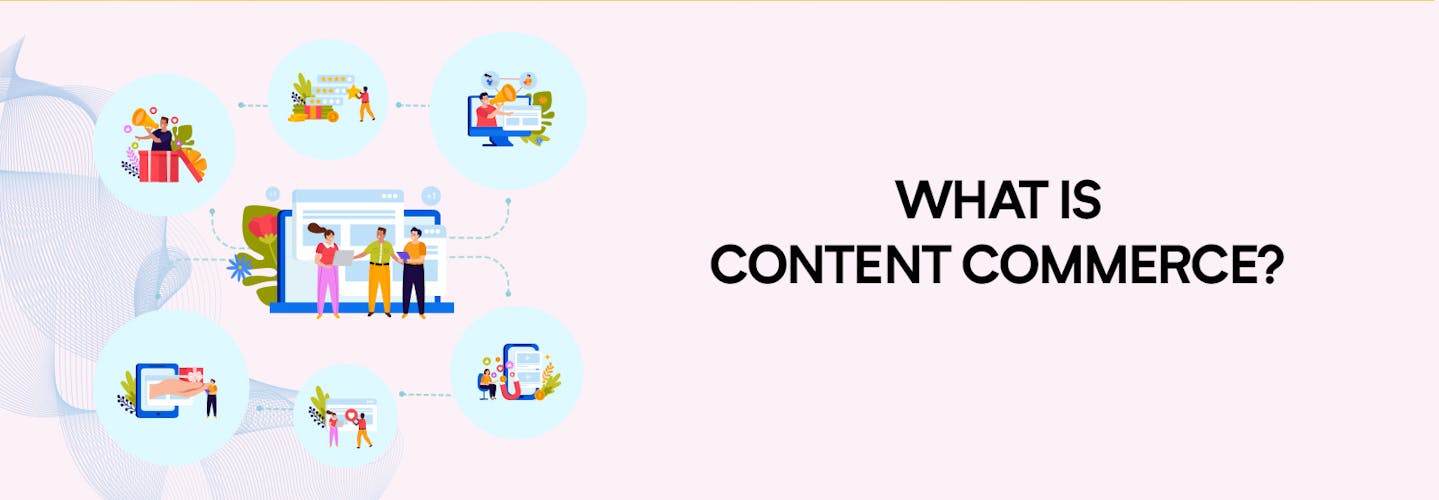
Content Commerce: What It Is and How It Can Benefit Your Business
In today’s digital age, the way consumers interact with brands has undergone a significant transformation.
With the rise of social media and e-commerce, brands have to find innovative ways to engage with their target audience and drive sales.
One of the most effective methods of achieving this is through content commerce.
In this article, we will explore the definition of content commerce, its importance, and how it has evolved over time.
What is Content Commerce?
Content commerce is a relatively new concept in the world of digital marketing, but it is quickly gaining popularity as a way for brands to connect with their customers and drive sales.
At its core, content commerce is the practice of using content to drive sales and engage with customers in a more meaningful way. This can be done through a variety of channels, including social media, blogs, and ecommerce platforms.
The Importance of Content Commerce
In today’s digital age, consumers are bombarded with advertisements everywhere they go.
With so many options available, it can be challenging for brands to stand out from the crowd.
Content commerce offers a unique solution to this problem by providing customers with an immersive and engaging experience that sets the brand apart from the competition.
Content commerce is also essential because it allows brands to build long-lasting relationships with their customers.
By creating content that resonates with their target audience, brands can establish themselves as thought leaders in their industry and earn the trust of their customers.
Another crucial aspect of content commerce is its ability to drive sales.
By providing customers with a seamless shopping experience that is integrated with engaging content, brands can increase conversions and drive revenue.
Brief History of Content Commerce
The concept of content commerce can be traced back to the early days of e-commerce.
In the 1990s, companies like Amazon and eBay were already using product reviews and customer ratings to drive sales. However, it wasn’t until the early 2000s that content commerce really began to take off.
One of the earliest examples of content commerce was the launch of the iTunes store in 2003. By combining music with e-commerce, Apple was able to provide customers with a seamless shopping experience that revolutionized the way people purchased music.
Over the years, content commerce has continued to evolve, with brands finding new and innovative ways to integrate content with e-commerce. Today, content commerce is a mainstream marketing strategy used by brands of all sizes.
The Intersection of Content and Commerce
Understanding the relationship between content and commerce is crucial for brands looking to leverage content commerce successfully.
In essence, content and commerce are two sides of the same coin, each serving a distinct purpose in the customer journey.
How Content Can Drive Commerce
One of the primary ways that content can drive commerce is by providing customers with valuable information that helps them make informed purchasing decisions.
This can be achieved through product reviews, instructional videos, and other types of content that showcase the benefits of a particular product or service
Another way that content can drive commerce is by creating an emotional connection with the customer. By telling a story or highlighting the values of the brand, content can help customers feel more connected to the brand and more likely to make a purchase.
How Commerce Can Drive Content
While content can drive commerce, commerce can also drive content. By analyzing customer behavior and purchasing patterns, brands can gain valuable insights into their target audience’s preferences and interests.
This information can then be used to create more targeted and personalized content that resonates with customers.
Additionally, by providing customers with a seamless shopping experience that is integrated with content, brands can encourage customers to share their experiences on social media and other channels.
This user-generated content can then be leveraged by the brand to create even more engaging content that drives sales.
Examples of Brands Successfully Fusing Content and Commerce
Numerous brands have successfully integrated content with commerce to drive sales and build brand loyalty.
1. Glossier:

One example is Glossier, a beauty brand that has built a massive following on social media by using user-generated content to showcase its products. By featuring photos and videos of real customers using its products, Glossier has been able to build a strong community of loyal fans who feel connected to the brand.
2. Nike:

Another example is Nike, which has been using content commerce to promote its products for years. By creating engaging content that showcases its products in action, Nike has been able to build a strong brand identity that resonates with customers.
Benefits of Content Commerce:
One of the major benefits of content commerce is that it allows brands to connect with customers on a more personal level.
By creating content tailored to their target audience’s interests and needs, brands can build trust and credibility with their customers. This can lead to increased brand loyalty and repeat business.
Additionally, by using affiliate marketing programs, brands can generate revenue from their content without having to directly sell products or services.
There are several benefits to implementing a content commerce strategy, including:
1.Increased revenue:
By providing a seamless purchasing experience within the content, brands can increase their sales and revenue. Content commerce allows brands to monetize their content, turning their audience into paying customers.
By providing a direct link to purchase within the content, brands can reduce the friction between the customer’s interest in the product and the purchase decision.
2.Improved customer engagement:
Content commerce allows brands to create a deeper connection with their audience by providing valuable and relevant content while also making it easy for them to make a purchase.
By providing a personalized and engaging experience, brands can keep their audience engaged for longer and increase the chances of conversion.
3.Increased brand loyalty:
Positive purchasing experiences can enable brands to increase customer loyalty and repeat business. Such brand experiences increase customers’ likelihood of returning and making additional purchases.
By providing a seamless and enjoyable purchasing experience, brands can increase customer loyalty and create a loyal customer base.
4.Enhanced customer insights:
By tracking and analyzing customer interactions with the content and commerce elements, brands can gain valuable insights into their audience’s needs and preferences.
This can be used to optimize the content and commerce strategy, making it more effective and efficient. Brands can then use this data to create more personalized and relevant content and to improve purchasing experiences further.
How to Implement Content Commerce?

To implement content commerce, brands first need to identify their target audience and create content tailored to their interests and needs.
This can be done by researching the target audience’s demographics, interests, and behavior and then creating content that aligns with these characteristics.
Implementing a content commerce strategy can be done in several ways, including:
1. Ecommerce Integration
Brands can integrate their ecommerce platform into their content, allowing customers to make a purchase directly from the content. This can be done by including a “Buy Now” button or a link to the product page within the content.
By providing a direct link to purchase, brands can reduce the friction between the customer’s interest in the product and the purchase decision.
2. Influencer Marketing
Brands can partner with influencers to create content that promotes their products and includes a link to purchase.
Influencer marketing has the potential to be a potent tool for expanding brand awareness and attracting new customers. By partnering with influencers, brands can leverage their audience and reach to promote their products and increase conversions.
3. Shoppable Content
Brands can create shoppable content, such as Instagram posts or YouTube videos, that allow customers to purchase products directly from the content. This can be done by tagging products in a post or video or by including a link to purchase within the post or video.
Shoppable content can be a powerful way to increase conversions, as it allows customers to make a purchase directly from the content they are engaging with.
How Can Brands Execute a Content Commerce Strategy?
To execute a content commerce strategy, brands need to develop a plan that outlines the goals and objectives of the campaign, as well as the tactics that will be used to achieve these goals.
This can include creating and publishing content, optimizing the content for search engines, and using calls to action to drive sales.
To execute a much successful content commerce strategy, brands should:
1. Identify their Brand’s Unique Value Proposition
The first step is to identify your brand’s unique value proposition. What sets your brand apart from the competition? What are your brand’s core values and mission?
2. Understand Your Audience’s Needs and Interests
The second step is to understand your target audience’s needs and interests. What are their pain points and challenges? What are their interests and hobbies? By understanding your target audience, you can create content that resonates with their needs and interests.
3. Create a Content Strategy
The third step is to create a content strategy that aligns with your brand’s unique value proposition and your target audience’s needs and interests.
This can include blog posts, videos, social media content, and other types of content that showcase your products and provide value to your target audience.
4. Choose the Right Technology and Platforms
The fourth step is to choose the right technology and platforms to support your content commerce strategy. This can include e-commerce platforms, content management systems, and analytics tools that allow you to measure and optimize your results.
5. Measure and Optimize Your Results
The final step is to measure and optimize your results. By analyzing metrics such as engagement, conversion rates, and revenue, you can identify areas for improvement and refine your content commerce strategy over time.
Power Your Content Commerce Strategy with Conventional Marketing
Brands can power their content commerce strategy with conventional marketing tactics to drive sales and increase revenue. Some ways to do this include:
1. Email marketing campaigns:
Brands can use email marketing campaigns to promote their content and drive traffic to their website. By sending targeted email campaigns to their subscriber list, brands can increase visibility and drive sales.
2. Paid advertising:
Brands can also use paid advertising on platforms such as Google AdWords, Facebook Ads, and Instagram Ads to drive traffic to their website and increase visibility.
3. Public relations:
Brands can use public relations to increase visibility and credibility by securing media coverage in relevant publications, websites, and blogs.
4. Trade shows and events:
Brands can attend trade shows and events to network and generate leads.
5. Referral marketing:
Brands can use referral marketing to incentivize existing customers to refer new customers to the brand.
6. Affiliate marketing:
Brands can also use affiliate marketing to generate revenue by partnering with other businesses or individuals to promote their products or services.
Challenges and Risks of Content Commerce:
While content commerce offers numerous benefits for brands, there are also several challenges and risks that brands need to be aware of. These include:
1. Balancing Content and Sales
One of the biggest challenges of content commerce is balancing content and sales. While it’s essential to provide customers with engaging content, brands also need to focus on driving sales and revenue.
2. Ensuring Authenticity and Transparency
Authenticity and transparency are crucial for building trust with customers. Brands need to ensure that their content and marketing strategies are authentic and transparent, or risk alienating their target audience.
3. Dealing with Negative Feedback
Negative feedback is an inevitable part of any marketing strategy. Brands need to have a plan in place for handling negative feedback and addressing customer concerns in a timely and professional manner.
4. Managing Data Privacy and Security
With the rise of data breaches and privacy concerns, brands need to be vigilant about protecting their customers’ data. By implementing robust data security measures, brands can build trust with their customers and protect their reputation.
Content Commerce in Different Industries:
Content commerce is a marketing strategy that can be applied to a wide range of industries. Some of the industries that have successfully integrated content with e-commerce include:

1. Fashion and Beauty
The fashion and beauty industry has been at the forefront of content commerce.
By creating engaging content that showcases their products in a unique and creative way, fashion and beauty brands have been able to build strong communities of loyal fans who feel connected to their brand.
2. Food and Beverage
The food and beverage industry has also successfully leveraged content commerce to engage with their target audience. By creating content that showcases their products in a unique and entertaining way, food and beverage brands have been able to drive sales and build brand loyalty.
3. Travel and Hospitality
The travel and hospitality industry has been using content commerce to showcase their products and provide customers with a seamless booking experience.
By integrating content with e-commerce, travel and hospitality brands can provide customers with all the information they need to make an informed decision.
4. Health and Wellness
The health and wellness industry has also been using content commerce to promote their products and services. By providing customers with valuable information and resources, health and wellness brands can build trust and credibility with their target audience.
5. Automotive
The automotive industry has been using content commerce to showcase their products and provide customers with an immersive and engaging shopping experience.
By using virtual and augmented reality technologies, automotive brands can allow customers to interact with their products in a unique and memorable way.
Conclusion:
Content commerce is a powerful marketing strategy that allows brands to engage with their target audience and drive sales. By integrating engaging content with e-commerce, brands can provide customers with a seamless shopping experience that sets them apart from the competition.
While there are challenges and risks associated with content commerce, the benefits far outweigh the drawbacks. With the continued growth of e-commerce and social media, content commerce is likely to become even more important in the future, making it an essential strategy for brands of all sizes.
To get started with content commerce, brands should identify their unique value proposition, understand their target audience’s needs and interests, create a content strategy, choose the right technology and platforms, and measure and optimize their results.
By following these steps, brands can build authentic and transparent relationships with their customers and drive revenue and loyalty.
Just started a business? Leverage aasaan’s full suite of no-code online storefront tools to build and grow your business the aasaan way.
FAQ’S:
1: How can content commerce benefit small businesses?
A: Content commerce can benefit small businesses by providing a cost-effective way to reach and engage with customers. By creating valuable and relevant content, small businesses can attract and retain customers, increase brand loyalty, and drive sales.
Additionally, by using affiliate marketing programs, small businesses can generate revenue from their content without having to invest in expensive advertising campaigns.
2: How can I measure the success of my content commerce strategy?
A: To measure the success of your content commerce strategy, you can track key metrics such as conversion rate, revenue generated from content, and customer engagement.
Additionally, you can use tools such as Google Analytics to track user behavior on your website and analyze the performance of your content and commerce elements. By monitoring these metrics, you can identify areas for improvement and optimize your strategy accordingly.
3: What are some best practices for creating content for content commerce?
A: Some best practices for creating content for content commerce include:
- Creating valuable and relevant content that aligns with your target audience’s interests and needs
- Incorporating calls to action within the content, such as “Buy Now” buttons or links to purchase
- Optimizing the content for search engines to increase visibility and drive traffic
- Using high-quality images and videos to enhance the user experience
- Personalizing the content to create a deeper connection with the audience
- Continuously analyzing and optimizing the content based on customer feedback and engagement data.
4: What are the differences between content commerce and affiliate marketing?
A: Content commerce is the practice of using content to drive sales and engage with customers. It involves creating content tailored to the target audience’s interests and needs and providing a seamless purchasing experience within the content.
On the other hand, affiliate marketing is a type of performance-based marketing where a business rewards one or more affiliates for each visitor or customer brought about by the affiliate’s own marketing efforts.
It can be part of a content commerce strategy where brands partner with influencers to create content that promotes their products and includes a link to purchase.








